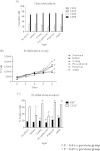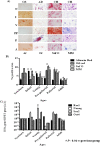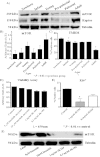Influence of age on rat bone-marrow mesenchymal stem cells potential
- PMID: 26581954
- PMCID: PMC4652164
- DOI: 10.1038/srep16765
Influence of age on rat bone-marrow mesenchymal stem cells potential
Abstract
Mesenchymal stem cells promising role in cell-based therapies and tissue engineering appears to be limited due to a decline of their regenerative potential with increasing donor age. Six age groups from bone marrow mesenchymal stem cells of Wistar rats were studied (newborn, infant, young, pre-pubertal, pubertal and adult). Quantitative proteomic assay was performance by iTRAQ using an 8-plex iTRAQ labeling and the proteins differentially expressed were grouped in pluripotency, proliferative and metabolism processes. Proliferation makers, CD117 and Ki67 were measure by flow cytometry assay. Real time polymerase chain reaction analysis of pluripotency markers Rex1, Oct4, Sox2 and Nanog were done. Biological differentiation was realized using specific mediums for 14 days to induce osteogenesis, adipogenesis or chondrogenesis and immunostain analysis of differentiated cell resulting were done. Enzimoimmunoassay analysis of several enzymes as L-lactate dehydrogenase and glucose-6-phosphate isomerase were also done to validate iTRAQ data. Taking together these results indicate for the first time that mesenchymal stem cells have significant differences in their proliferative, pluripotency and metabolism profiles and those differences are age depending.
Figures





References
-
- Zhang L. et al. The Effects of Mesenchymal Stem Cells in Craniofacial Tissue Engineering. Current Stem Cell Research & Therapy. 9, 280–289 (2014). - PubMed
-
- Yeh H. Y. et al. Neocartilage formation from mesenchymal stem cells grown in type II collagen-hyaluronan composite scaffolds. Differentiation. 86, 171–183 (2014). - PubMed
Publication types
MeSH terms
Substances
LinkOut - more resources
Full Text Sources
Other Literature Sources
Medical
Research Materials

